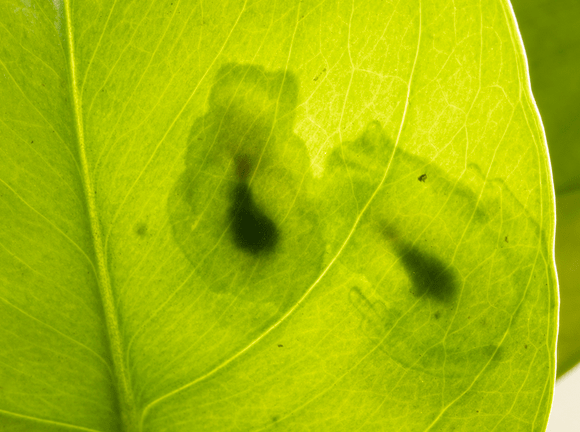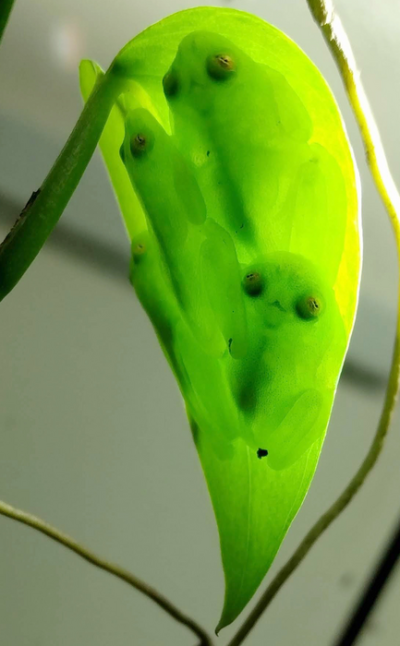By Hiding Their Blood, These Frogs Pull Off The Ultimate Disappearing Act
6:52 minutes


Glass frogs have a superpower: If you look at them from above, they look like regular green frogs. But if you flip one over, you can see right into their bodies: hearts, intestines, bones, and all.
As these frogs doze off, however, something changes: They disappear. Well, almost. A new study shows that the frogs can hide their red blood cells as they sleep, becoming expert camouflagers.
Dr. Carlos Taboada, a biologist at Duke University, is a co-author on this study and he joins Ira to talk about the glass frogs’ tricks.
Invest in quality science journalism by making a donation to Science Friday.
Dr. Carlos Taboada is a biologist at Duke University in Durham, North Carolina.
IRA FLATOW: Have you ever heard of a glass frog? They are these little frogs found all over Central and South America. And what’s incredible about them is that they look green from the top, but if you flip one over, it looks like– you guessed it– glass. You’ll see their hearts, their intestines, their bones, and everything.
But as these frogs doze off, something almost magical happens– the frogs disappear. Well, almost. Here to tell us how these frogs pull off such a unique magic trick is my guest Dr. Carlos Taboada, biologist at Duke University based in Durham, North Carolina. Welcome to Science Friday.
CARLOS TABOADA: Thank you so much for having me here.
IRA FLATOW: You’re welcome. Let’s get into the details because this is some amazing trick. How do the frogs do it?
CARLOS TABOADA: What we found basically is the animals can pull out 90% of their red blood cells when they sleep and basically aggregate all of those cells inside of the livers, basically to remove most of the pigments that would normally create an opaque animal, like us, for example.
IRA FLATOW: That’s really interesting. Why does it only happen when they’re sleeping?
CARLOS TABOADA: We’re still trying to figure that out. What we know is that when they sleep, in a way, they’re less aware of predators. They become transparent. And they reduce their metabolic rates. In a way, it’s a tradeoff. They can do it while they sleep if they stay motionless without a big oxygen supply. When they are awake, they need to meet their metabolic needs because they start chasing preys. They start breeding, vocalizing, and they need more oxygen. So it’s then when they become opaque and cannot hide their red blood cells anymore.
IRA FLATOW: Is it possibly a defense mechanism for when they’re sleeping when they get transparent? They’re not seen so easily by predators.
CARLOS TABOADA: That’s interesting. I mean, there’s some evidence that shows that transparency can help them camouflage. And that’s what we also found. I mean, the optical properties are like a leaf. So basically they match the vegetation perfectly where they sleep during the day.
There’s evidence that some predators might not see them during this time because in this case, transparency works really well because we’re used to seeing animals in terms of reflected light. All of the colors that we see in nature come from the way that the light reflects on a surface. In this case, we need to think about animals being viewed through leaves and also on reflected light. So this is a really complex form of camouflage that might help.
IRA FLATOW: When you discover that all the red blood cells were sort of heading to the liver, how surprising was that for you?
CARLOS TABOADA: Well, it was amazing. We had never seen anything like that because transparency was the mystery in glass frogs. But then after after we found out, we started doing some research and discovered that there is some sort of ancestral mechanism in frogs. I mean, there’s some evidence that other European common frogs under really specific experimental conditions that induce some sort of induced coma in really well oxygenated environments and really cold temperatures, they can store, to some extent, some red blood cells.
They do that in a way that could mimic hibernation or torpor physiology. In this case, it was really surprising to see that glass frogs could push this to the limit, go from around 40% storage to 90% of the whole pool. And they could do it even at high temperatures, and every day on a circadian rhythm basis. That was the most interesting thing. Not only the amount that they could store in the livers, but also that they could do it at really, really high temperatures and daily.
IRA FLATOW: That’s amazing. I imagine if you’re packing a whole lot of red blood cells into one tiny space– as you said, that’s what happens– couldn’t that cause some problems? I mean, is their liver specially made to be able to handle all of this?
CARLOS TABOADA: In a way, they do. The liver increases its volume by 40% when they pack all of their red blood cells. There’s two distinctive traits in their livers. One is that they are covered with mirror-like structures that are millions, millions of nanocrystals packed inside of a tissue that basically help them reflect most of the light. So we cannot see the red blood cells through the livers.
And the other thing that is important is that in many other vertebrates, the livers are pretty distensible. They have capillaries, which, in livers, are called sinusoids. That is the place where most of the interchanges of metabolites occur. The fact that they do it, in a way, requires other adaptations that allow them to aggregate all of their red blood cells without triggering a clot. That’s what would normally happen to other animals for those concentrations and packing of red blood cells.
IRA FLATOW: But somehow, the frogs can do it without getting a blood clot.
CARLOS TABOADA: They can do it. They can do it pretty well, while at the same time, they can still clot when they need it. Even when they are sleeping, in their liver, everything is fine. But if the animals are injured, for example, by a predator, they can still clot luckily. So their whole coagulation system is functional. But they can, in a way, split two functions. One is clotting normally and non-clotting pathologically.
IRA FLATOW: Well, if they can store all this blood in the liver without it coagulating, and they can do all this magical stuff with it, is there anything that we could apply to human medicine to learn from the frog?
CARLOS TABOADA: Oh, certainly. Normally, when there are pathological clots, people are treated with anticoagulants, and these anticoagulants, sometimes they can induce some excessive bleeding in patients. We don’t really know yet the mechanisms that this frog used to basically avoid the formation of a big clot.
But certainly, they deserve some research to figure it out. They clearly have a way to compartmentalize different pathways of coagulation. And they can somehow prevent it probably using a local anticoagulant. And so we need to find those genetic tricks that probably do something translational. That is something that we are exploring right now. And hopefully we’ll have some results in the near future.
IRA FLATOW: OK, well, you come back and tell us about it, OK? When you find that out.
CARLOS TABOADA: I’d be happy to.
IRA FLATOW: Well, thank you, doctor, for taking time to be with us today.
CARLOS TABOADA: Of course. Thank you for having me here.
IRA FLATOW: Dr. Carlos Taboada is a biologist at Duke University based in Durham, North Carolina. If you’d like to see these frogs hide their blood, visit sciencefriday.com/glassfrogs.
Copyright © 2023 Science Friday Initiative. All rights reserved. Science Friday transcripts are produced on a tight deadline by 3Play Media. Fidelity to the original aired/published audio or video file might vary, and text might be updated or amended in the future. For the authoritative record of Science Friday’s programming, please visit the original aired/published recording. For terms of use and more information, visit our policies pages at http://www.sciencefriday.com/about/policies/.
Rasha Aridi is a producer for Science Friday and the inaugural Outrider/Burroughs Wellcome Fund Fellow. She loves stories about weird critters, science adventures, and the intersection of science and history.
Ira Flatow is the founder and host of Science Friday. His green thumb has revived many an office plant at death’s door.